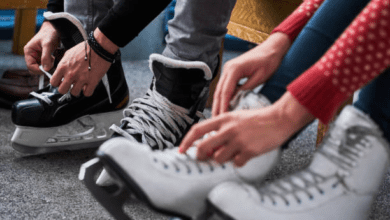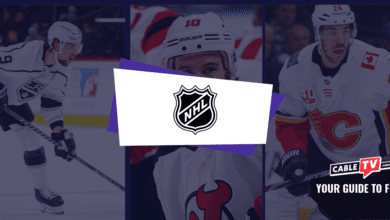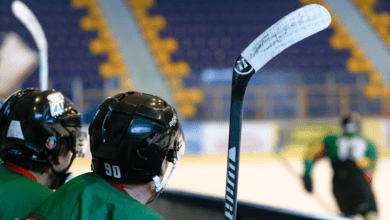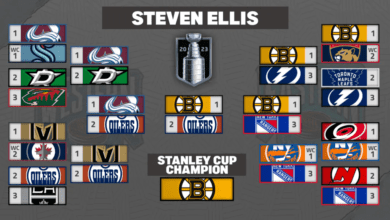How to Improve Your Hockey Shooting Accuracy

Introduction
How to Improve Your Hockey Shooting Accuracy, Shooting accuracy is a crucial skill for hockey players. The ability to place your shots precisely can significantly impact your team’s offensive performance and increase your chances of scoring goals. In this article, we will explore various tips and techniques to help you improve your hockey shooting accuracy and become a more effective player on the ice.
How to Improve Your Hockey Shooting Accuracy
Tip 1: Focus on Technique and Fundamentals
To improve your shooting accuracy, it’s important to focus on the fundamentals of shooting technique. Start by mastering your grip on the stick and positioning your hands correctly. Maintain a strong and balanced stance, with your weight evenly distributed. As you shoot, generate power through your legs and transfer it smoothly to your upper body. Pay attention to your follow-through and ensure that it remains consistent.
Tip 2: Practice Proper Puck Control
Puck control plays a significant role in shooting accuracy. Work on your stickhandling skills to maintain control of the puck as you approach the net. Practice quick and precise movements with the puck, allowing you to release accurate shots in various game situations. The better you can control the puck, the more accurate your shots will become.
Tip 3: Develop Quick Release Techniques
In hockey, shooting quickly can catch goaltenders off guard and lead to higher scoring opportunities. Practice developing a quick release by working on your hand and wrist strength. Focus on releasing the puck rapidly without sacrificing accuracy. Utilize shooting drills that simulate game scenarios, enabling you to react swiftly and get your shot off with precision.
Tip 4: Aim for Specific Targets
When we talk about aiming for specific targets in hockey shooting, it means intentionally directing your shots towards specific areas of the net with precision. Rather than just shooting at the general area of the goal, focusing on specific targets can greatly enhance your shooting accuracy.
By visualizing and aiming for specific spots on the net, such as the corners, top shelf, or other specific areas, you develop a greater sense of control over your shots. This level of precision allows you to exploit the gaps and weaknesses in the goaltender’s positioning, increasing your chances of scoring goals.
Aiming for specific targets also helps you develop a more consistent and repeatable shooting technique. It encourages you to focus on proper weight transfer, hand placement, and follow-through to accurately hit your desired target. With consistent practice, you train your muscle memory to execute these techniques effectively, leading to improved shooting accuracy in game situations.
Moreover, aiming for specific targets enhances your decision-making on the ice. As you become more comfortable with different target areas, you can quickly assess the goaltender’s positioning and make split-second decisions on where to shoot the puck. This adaptability and quick decision-making give you an edge in scoring goals and contribute to your overall effectiveness as a shooter.
It’s important to note that aiming for specific targets doesn’t mean ignoring other viable shooting opportunities. Hockey is a fast-paced sport, and shooting situations can change rapidly. Sometimes, shooting for the general areas of the net may be the best option, such as when a quick release or a deflection is required. Aiming for specific targets should be seen as a skill to enhance your shooting accuracy, but it should also be complemented by the ability to adapt and take advantage of different scoring opportunities.
By incorporating the practice of aiming for specific targets into your training sessions, you can develop the precision, control, and decision-making skills necessary to become a more accurate and effective shooter in hockey.
Tip 5: Work on Shooting in Various Positions
In a game, shooting opportunities can arise from different positions and angles. To enhance your shooting accuracy, practice shooting from a variety of positions such as stationary, while moving, off one foot, or in tight spaces. This versatility will allow you to adapt to different game situations and increase your scoring potential from various angles.
Tip 6: Incorporate Game-like Scenarios into Practice
Incorporating game-like scenarios into practice involves designing drills and exercises that closely mimic real-game situations. The goal is to recreate the pressure, speed, and decision-making aspects of an actual hockey game. By practicing in these realistic scenarios, players can improve their ability to perform under pressure and make accurate shots during game situations.
Here’s how you can incorporate game-like scenarios into your shooting practice:
- Positioning and Timing: Set up drills that require players to position themselves in game-like spots on the ice. For example, create a drill where players receive passes in the slot or practice shooting from the faceoff circles. This helps simulate shooting opportunities that players encounter during games and allows them to work on their accuracy from specific areas.
- Moving Targets: Incorporate moving targets into shooting drills. Use teammates, coaches, or even mobile equipment to create dynamic shooting opportunities. For instance, have a player skate across the goalmouth, simulating a defenseman’s movement, while you try to hit the target with your shot. This helps improve shooting accuracy while dealing with moving obstacles, just like in a game situation.
- Time Pressure: Introduce time constraints or pressure situations to simulate the fast-paced nature of a game. For example, set a specific time limit for a player to receive a pass and shoot before a defender closes in. This encourages players to make quick decisions and release accurate shots under time pressure, replicating real-game scenarios.
- Game-like Drills: Develop drills that incorporate multiple players, such as 2-on-1 or 3-on-2 situations. These drills create opportunities for players to practice shooting accuracy while navigating through defenders and making split-second decisions. By simulating game scenarios with teammates, players can enhance their shooting accuracy in a dynamic and competitive environment.
- Recreating Game Situations: Analyze game footage to identify specific scenarios where shooting accuracy can be improved. For example, if you notice that you often miss shots when skating at high speed, design drills that simulate those scenarios. By replicating game situations that pose challenges for shooting accuracy, you can target areas of improvement and work on them directly.
Incorporating game-like scenarios into practice allows players to transfer their shooting skills from practice sessions to real games. It helps build muscle memory, decision-making abilities, and composure under pressure. By repeatedly practicing in scenarios that closely resemble actual game situations, players can develop the confidence and accuracy necessary to perform at their best when it matters most.

Conclusion
Improving your hockey shooting accuracy takes practice, focus, and attention to detail. By focusing on technique and fundamentals, practicing proper puck control, developing quick release techniques, aiming for specific targets, working on shooting from various positions, and incorporating game-like scenarios into your practice, you can enhance your accuracy and become a more effective shooter on the ice. Remember to be persistent, stay dedicated to your training, and apply these tips consistently to see significant improvements in your shooting accuracy.
More Posts
How to Place Successful Football Bets
How to Draft a Winning Fantasy Football Team
How to Stay Updated with IPL News and Player Performances
How to Improve Your Football Skills
FAQs
Q1: How long does it take to improve shooting accuracy in hockey?
Improving shooting accuracy is a gradual process that requires consistent practice over time. The amount of time it takes to see improvements varies depending on factors such as the individual’s skill level, dedication to practice, and the frequency of training sessions. With regular and focused practice, significant improvements can be achieved within a few months.
Q2: Are there any specific off-ice exercises to improve shooting accuracy?
Yes, there are several off-ice exercises that can help improve shooting accuracy. These include wrist strengthening exercises, stickhandling drills, and practicing shooting technique without a puck. Additionally, working on core stability and leg strength can also contribute to improved shooting accuracy on the ice.
Q3: How important is visualization in improving shooting accuracy?
Visualization can be a valuable tool in improving shooting accuracy. By visualizing successful shots and specific targets in your mind, you can enhance your focus and develop a greater sense of precision. Combine visualization with on-ice practice to maximize its effectiveness in improving your shooting accuracy.
Q4: Can shooting with a weighted puck or ball help improve accuracy?
Shooting with a weighted puck or ball can be a useful training tool to improve shooting accuracy. The added resistance challenges your muscles and forces you to focus on technique and follow-through. However, it’s important to balance weighted puck training with regular shooting practice to maintain proper shooting form and avoid overexertion.
Q5: How can I measure my shooting accuracy progress?
One way to measure your shooting accuracy progress is to track your shooting percentage during practice sessions or games. Keep a record of the number of shots taken and the number of goals scored. Over time, you can assess your improvement by comparing shooting percentages from different periods. Additionally, feedback from coaches or teammates can provide valuable insights into your shooting accuracy progress.






One Comment